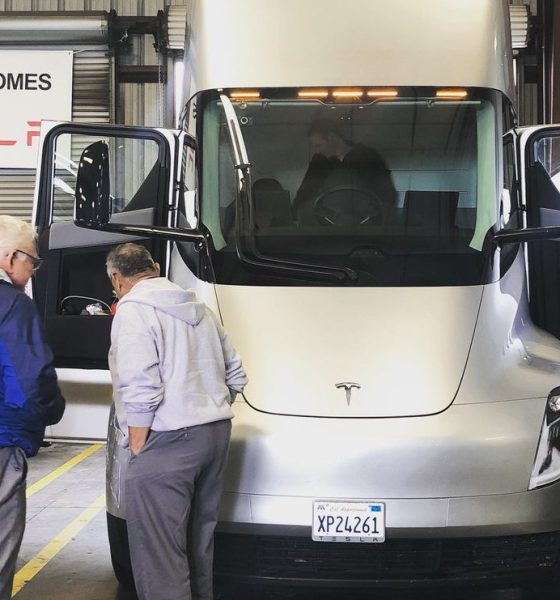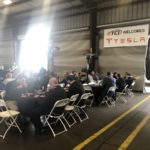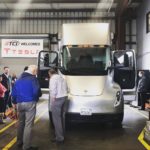

News
Tesla Semi gets closer to production amid test drive event for reservation holder
If Elon Musk’s initial timeframe for the Tesla Semi is accurate, initial production for the all-electric long-hauler should begin sometime this year. While Tesla has been tight-lipped about where the vehicle would be manufactured, the company appears to be showing confidence that the Semi is getting closer to production. Take, for one, the test drive events that Tesla has been holding with some of the Semi’s reservation holders.
On Wednesday, truck leasing company TCI Transportation shared a post on its official Twitter account. The company noted that they were visited by the Tesla Semi, and that some of its employees were even given test drives on the vehicle. Images from the event show TCI’s employees inspecting the all-electric long-hauler, and everyone in the event sharing a meal together.
TCI Transportation is not one of the companies that announced reservations for the Tesla Semi immediately after the vehicle was unveiled. Instead, the truck leasing company posted about its electric truck order last April, stating that they have ordered 50 units of the Tesla Semi. In its announcement, TCI noted that co-Presidents Ryan and Andrew Flynn were able to take the Semi out for a spin.
- Tesla Semi visits TCI Transportation. (Photo: TCI/Twitter)
- Tesla Semi visits TCI Transportation. (Photo: TCI/Twitter)
- Tesla Semi visits TCI Transportation. (Photo: TCI/Twitter)
- Tesla Semi visits TCI Transportation. (Photo: TCI/Twitter)
Tesla Semi visits TCI Transportation. (Photo: TCI Transportation/Twitter)
Perhaps interestingly, TCI’s recent post about the Tesla Semi saw the truck leasing company describe the all-electric long-hauler as a “new Tesla Semi Tractor Prototype,” a curious way of describing the vehicle. In its announcement last year, TCI simply called the vehicle as the “new Tesla Electric Semi truck.” While this difference could simply be a matter of simple syntax, the Semi’s new description from the leasing firm invokes the idea that the electric truck has probably been improved to a degree over the past year.
Tesla, after all, has been doing real-world tests using the Semi’s silver test mule. Not long after the vehicle was unveiled, the Semi had been spotted doing cargo runs or running routes across the United States — and it has not really stopped since. Even the matte black Semi prototype, which was recently wrapped in a stunning red color, has been spotted several times testing on America’s roads.
Through these tests, Tesla continues to refine the electric long-hauler, ensuring that the truck is at its best iteration possible when it enters production. Elon Musk already teased some of these improvements in the past. For example, Tesla initially announced two range options for the Semi — a 300-mile short range variant and a 500-mile long range version. In later statements though, Musk stated that the long-range variant of the Semi would have closer to 600 miles of range per charge.
When the Tesla Semi was initially unveiled, the vehicle attracted a notable amount of skepticism from some established players in the legacy trucking market. Daimler Trucks CEO Martin Daum, for one, infamously even joked that the specs Elon Musk quoted for the Semi suggest that the vehicle defies the laws of physics. In a more recent statement, though, Daum was far less dismissive. While the Daimler Trucks CEO still maintained that Tesla would have challenges breaching the trucking market, Daum nonetheless admitted that Tesla has shown that it has the determination to move forward.
“They’re fun; it’s an interesting market. We take every competitor seriously; Tesla has proved they really have the tenacity to really go through huge losses to capture the market. But trucking is a difficult business. They will learn the hard way; trucking is not like passenger cars where one size fits all. There’s a lot of variety in trucking… the United States is a highly competitive market, so as I said, they’re fun,” Daum said.

News
Tesla starts showing how FSD will change lives in Europe
Local officials tested the system on narrow country roads and were impressed by FSD’s smooth, human-like driving, with some calling the service a game-changer for everyday life in areas that are far from urban centers.

Tesla has launched Europe’s first public shuttle service using Full Self-Driving (Supervised) in the rural Eifelkreis Bitburg-Prüm region of Germany, demonstrating how the technology can restore independence and mobility for people who struggle with limited transport options.
Local officials tested the system on narrow country roads and were impressed by FSD’s smooth, human-like driving, with some calling the service a game-changer for everyday life in areas that are far from urban centers.
Officials see real impact on rural residents
Arzfeld Mayor Johannes Kuhl and District Administrator Andreas Kruppert personally tested the Tesla shuttle service. This allowed them to see just how well FSD navigated winding lanes and rural roads confidently. Kruppert said, “Autonomous driving sounds like science fiction to many, but we simply see here that it works totally well in rural regions too.” Kuhl, for his part, also noted that FSD “feels like a very experienced driver.”
The pilot complements the area’s “Citizen Bus” program, which provides on-demand rides for elderly residents who can no longer drive themselves. Tesla Europe shared a video of a demonstration of the service, highlighting how FSD gives people their freedom back, even in places where public transport is not as prevalent.
What the Ministry for Economic Affairs and Transport says
Rhineland-Palatinate’s Minister Daniela Schmitt supported the project, praising the collaboration that made this “first of its kind in Europe” possible. As per the ministry, the rural rollout for the service shows FSD’s potential beyond major cities, and it delivers tangible benefits like grocery runs, doctor visits, and social connections for isolated residents.
“Reliable and flexible mobility is especially vital in rural areas. With the launch of a shuttle service using self-driving vehicles (FSD supervised) by Tesla in the Eifelkreis Bitburg-Prüm, an innovative pilot project is now getting underway that complements local community bus services. It is the first project of its kind in Europe.
“The result is a real gain for rural mobility: greater accessibility, more flexibility and tangible benefits for everyday life. A strong signal for innovation, cooperation and future-oriented mobility beyond urban centers,” the ministry wrote in a LinkedIn post.
News
Tesla China quietly posts Robotaxi-related job listing
Tesla China is currently seeking a Low Voltage Electrical Engineer to work on circuit board design for the company’s autonomous vehicles.

Tesla has posted a new job listing in Shanghai explicitly tied to its Robotaxi program, fueling speculation that the company is preparing to launch its dedicated autonomous ride-hailing service in China.
As noted in the listing, Tesla China is currently seeking a Low Voltage Electrical Engineer to work on circuit board design for the company’s autonomous vehicles.
Robotaxi-specific role
The listing, which was shared on social media platform X by industry watcher @tslaming, suggested that Tesla China is looking to fill the role urgently. The job listing itself specifically mentions that the person hired for the role will be working on the Low Voltage Hardware team, which would design the circuit boards that would serve as the nervous system of the Robotaxi.
Key tasks for the role, as indicated in the job listing, include collaboration with PCB layout, firmware, mechanical, program management, and validation teams, among other responsibilities. The role is based in Shanghai.
China Robotaxi launch
China represents a massive potential market for robotaxis, with its dense urban centers and supportive policies in select cities. Tesla has limited permission to roll out FSD in the country, though despite this, its vehicles have been hailed as among the best in the market when it comes to autonomous features. So far, at least, it appears that China supports Tesla’s FSD and Robotaxi rollout.
This was hinted at in November, when Tesla brought the Cybercab to the 8th China International Import Expo (CIIE) in Shanghai, marking the first time that the autonomous two-seater was brought to the Asia-Pacific region. The vehicle, despite not having a release date in China, received a significant amount of interest among the event’s attendees.
Elon Musk
Elon Musk and Tesla AI Director share insights after empty driver seat Robotaxi rides
The executives’ unoccupied tests hint at the rapid progress of Tesla’s unsupervised Robotaxi efforts.

Tesla CEO Elon Musk and AI Director Ashok Elluswamy celebrated Christmas Eve by sharing personal experiences with Robotaxi vehicles that had no safety monitor or occupant in the driver’s seat. Musk described the system’s “perfect driving” around Austin, while Elluswamy posted video from the back seat, calling it “an amazing experience.”
The executives’ unoccupied tests hint at the rapid progress of Tesla’s unsupervised Robotaxi efforts.
Elon and Ashok’s firsthand Robotaxi insights
Prior to Musk and the Tesla AI Director’s posts, sightings of unmanned Teslas navigating public roads were widely shared on social media. One such vehicle was spotted in Austin, Texas, which Elon Musk acknowleged by stating that “Testing is underway with no occupants in the car.”
Based on his Christmas Eve post, Musk seemed to have tested an unmanned Tesla himself. “A Tesla with no safety monitor in the car and me sitting in the passenger seat took me all around Austin on Sunday with perfect driving,” Musk wrote in his post.
Elluswamy responded with a 2-minute video showing himself in the rear of an unmanned Tesla. The video featured the vehicle’s empty front seats, as well as its smooth handling through real-world traffic. He captioned his video with the words, “It’s an amazing experience!”
Towards Unsupervised operations
During an xAI Hackathon earlier this month, Elon Musk mentioned that Tesla owed be removing Safety Monitors from its Robotaxis in Austin in just three weeks. “Unsupervised is pretty much solved at this point. So there will be Tesla Robotaxis operating in Austin with no one in them. Not even anyone in the passenger seat in about three weeks,” he said. Musk echoed similar estimates at the 2025 Annual Shareholder Meeting and the Q3 2025 earnings call.
Considering the insights that were posted Musk and Elluswamy, it does appear that Tesla is working hard towards operating its Robotaxis with no safety monitors. This is quite impressive considering that the service was launched just earlier this year.












